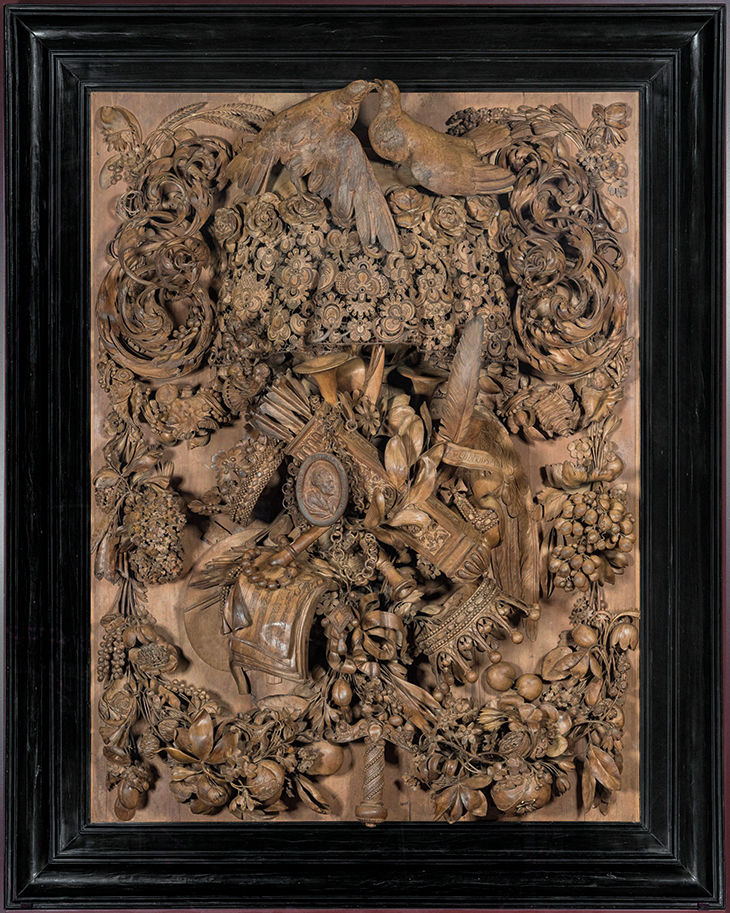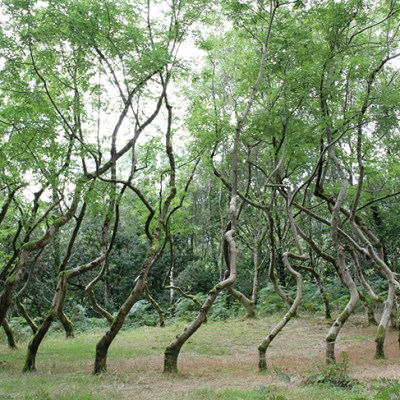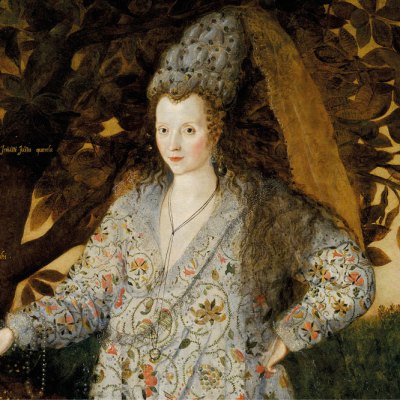From the July/August 2021 issue of Apollo. Preview and subscribe here.
On my walks around Clerkenwell, when I lived in that part of London, I often found myself outside a hefty early 20th-century building that sits just off Rosebery Avenue. More intriguing to me than the building itself was what lay out of reach behind it: an expanse of landscaped gardens, water features and, at a distance, a group of unusual-looking early Georgian structures. The block on Rosebery Avenue, as I discovered, now houses luxury apartments, but the initials ‘MWB’ on its imposing doors testify to its incarnation, from 1920 to the ’70s, as the head-quarters of the Metropolitan Water Board, Thames Water’s predecessor. The large site it occupies is the New River Head, the end point of a channel dug in the early 17th century to bring fresh water in to the city from springs in Hertfordshire some 32km north.
What I discovered later still was that the century-old Metropolitan Water Board building conceals an extraordinary remnant from the early days of this watery history: a Court Room, or boardroom, created for the ‘Water House’ of the New River Company in the 1690s and moved wholesale, when that building was demolished, to become a wonderful incongruity on the first floor of its new home. Along with a plasterwork ceiling frothy with sea creatures, Neptunes and nymphs, with a painted portrait of William III at its centre, the room boasts oak panelling with adornments traditionally attributed to that doyen of decorative woodcarving, Grinling Gibbons. A large crab scuttles down one side of the overmantel surround, its smooth carapace setting off the seething mass of detail around it: smaller crustaceans, the grooves and whorls of seashells and acanthus leaves, delicate flower petals. On the other side, a catch of fish hangs from a lobster brandishing its pincers like boxing gloves, above which is one of those great showpieces of the carver’s virtuosity, a rope net, this one heavy with shellfish.
That these carvings were executed by Grinling Gibbons himself has never in fact been established. They might have been done by someone in his workshop; or, more likely, one of the highly skilled English carvers working at the same time as Gibbons – often on some of the same big projects. In a way, whether the carving here is or is not Gibbons is a moot point: the fact that work like this is so often unhesitatingly attributed to him shows the extent to which he made this field his own.
Grinling Gibbons (based on a work of c. 1690), after Sir Godfrey Kneller. National Portrait Gallery, London

The arc of Gibbons’ career in England corresponds closely to the period dubbed ‘English Baroque’. He arrived here shortly after the Restoration, and died 300 years ago, in August 1721 – seven years after the death of Queen Anne. Crucially for the sensibility and technique that would set him apart from his contemporaries, Gibbons had been born and raised in Rotterdam, to an English merchant family. His move at the age of 19 to England – where he worked briefly in York, before settling in the capital – came about a year after the Great Fire of London, and may have been partly prompted by the lure of work opportunities that the reconstruction of the city offered craftsmen. At first, however, he operated as a ship carver in Deptford, which is where, ‘in a poore solitary thatched house’, the diarist John Evelyn claims to have ‘discovered’ Gibbons in 1671. As Evelyn relates, the young carver had been working on a relief after Tintoretto’s Crucifixion in the Scuola di San Rocco, Venice – ‘such a work,’ writes Evelyn, ‘as for the curiosity of handling, drawing & studious exactnesse, I never in my life had seene before in all my travells’.
The well-connected Evelyn lost little time attempting to launch Gibbons’ career, introducing him (and his relief) to Samuel Pepys, Christopher Wren, and the king himself. Success, however, didn’t come speedily: Wren seems not to have rated his work, employing his services many years later only after Gibbons had made a name for himself. Meanwhile, the ‘popeish’ nature of his Crucifixion may have scared off Charles II at a time when overt displays of Catholicism in England were to be avoided like the recent Great Plague.
Limewood carving by Grinling Gibbons, in the Carved Room (c. 1692) at Petworth House, West Sussex Photo: The National Trust Photolibrary/Alamy Stock Photo

Happily for Gibbons, he managed what would today be termed a ‘career pivot’. And perhaps it’s entirely appropriate that, in Restoration London, with playhouses recently reopened and all the world a stage once more, the project that set him firmly on the path to success was a theatre. In his decorative carvings at the new Dorset Garden Theatre (an idea of which survives in contemporary woodcuts), ‘Gibbons began,’ writes the late Gibbons devotee David Esterly, ‘to lavish on flower and leaf the attention he once brought to saint or angel’. His work there found an admirer in Peter Lely, whose recommendation to the king seems to have carried weight; by 1677 Gibbons was working at Windsor Castle, after which he would go on to create his elaborate decorative carvings for some of the greatest interiors of the era: Petworth, Badminton, Whitehall, Kensington Palace, Hampton Court, Blenheim.
Across the walls of these great houses Gibbons was translating into three dimensions – or very nearly three – the Dutch still-life paintings that were exciting British society at the time, and with which, it’s fair to presume, he was more familiar than his fellow carvers in England. How it was that Gibbons could bring to wood, as Horace Walpole put it, ‘the loose and airy lightness of flowers’ was also helped by his European-influenced medium of choice. For while he did occasionally carve in oak, for instance at St Paul’s Cathedral, Gibbons worked mainly with limewood (a compelling argument for the New River carvings not being Gibbons). As Esterly writes, ‘In the struggle to create naturalistic leaves and flowers and fruits, the least recalcitrant foe of the chisel is limewood’; its grain structure gives it the ideal combined qualities of softness and structural strength, allowing Gibbons his radically thin leaf edges and stems.
The Cosimo panel (1682), Grinling Gibbons. Palazzo Pitti, Florence. Photo / courtesy Gallerie degli Uffizi

Another innovation the Rotterdam-born carver brought with him was to leave his naturally cream-coloured carvings nude, without paint or stain. The effect of this was to make them sing out against the mostly darker oak panelling to which he was attaching them, appliqué-style. The Victorian mania for varnish means the effect of this is mostly lost to us – which is partly why, for all the magnificence of those grand room schemes in stately homes, it’s the standalone works Gibbons made that do it for me. In such works he was repositioning himself as an artist, rather than a craftsman – witness the bravura of his so-called Cosimo panel, commissioned by Charles II as a gift for the Duke of Tuscany: the decorative elements in the surrounds Gibbons made for the overmantels and paintings at Petworth and elsewhere here shift, in a virtuosic display, to become the central artwork itself.
One of that panel’s most impressive elements is a canopy-like hang of Venetian needlepoint lace, simulating in wood the luxurious material that can be seen at the necks of grand men (Gibbons included) in portraits of the time. In c. 1690 Gibbons made a playful calling card for his talent in the form of just such a cravat. Walpole, who to some extent revived Gibbons’ reputation in later decades, came to own this extraordinary object, and in 1769 wore it to receive some European guests at Strawberry Hill. No doubt they were taken in by it – before, one hopes, being shown its masterful skill. Where’s the fun in artifice if you don’t find out you’ve been tricked?
For information on Grinling Gibbons tercentenary events, visit www.grinling-gibbons.org.
From the July/August 2021 issue of Apollo. Preview and subscribe here.


